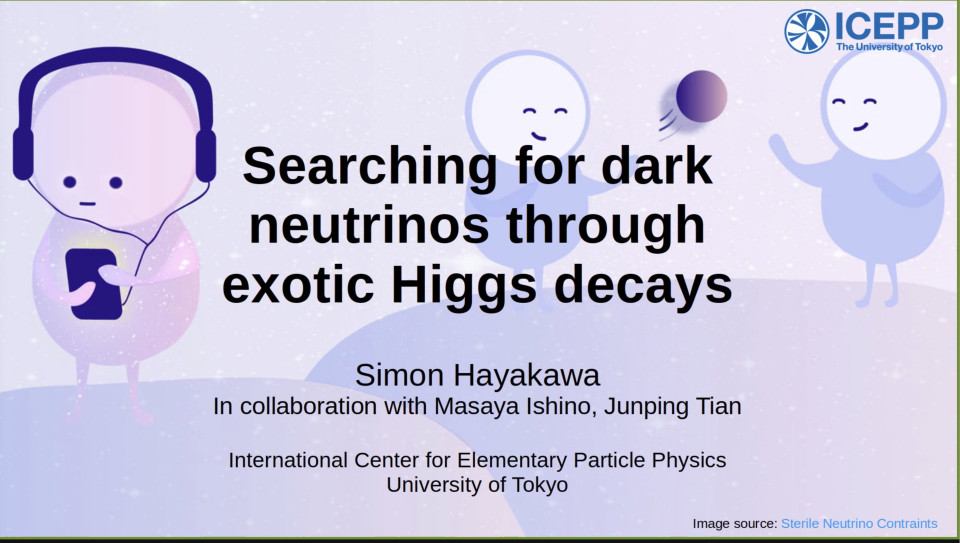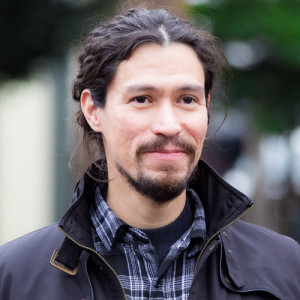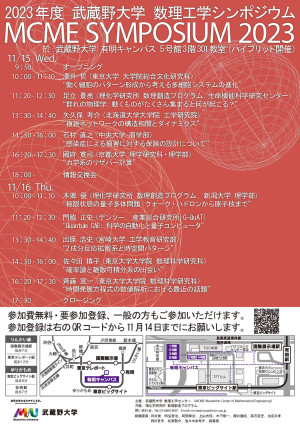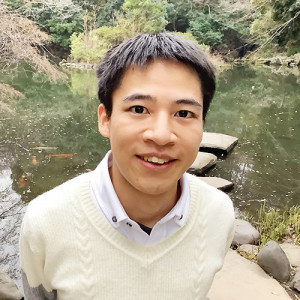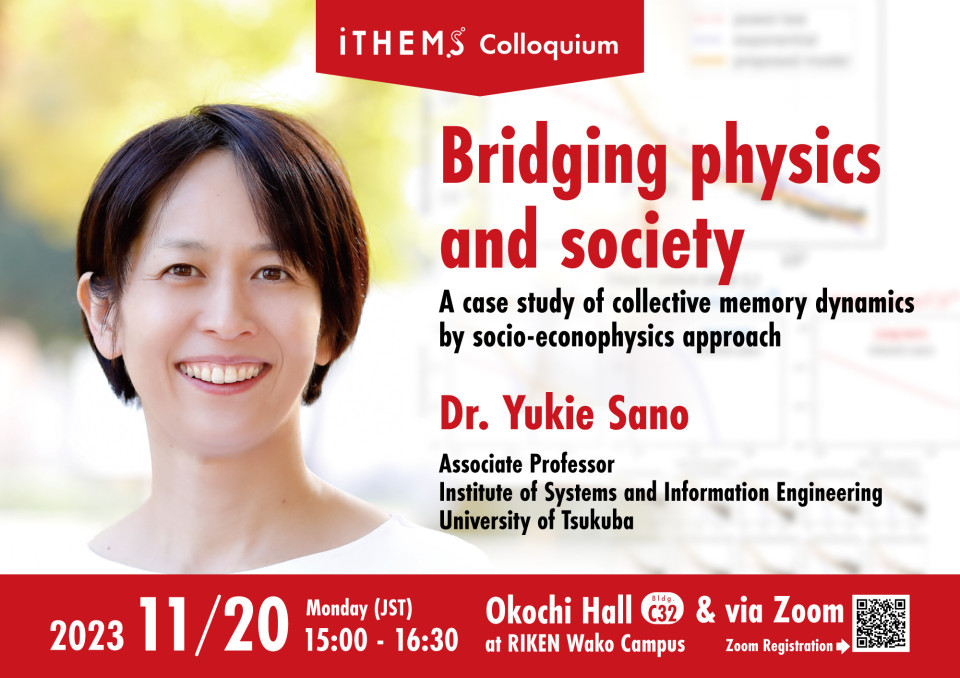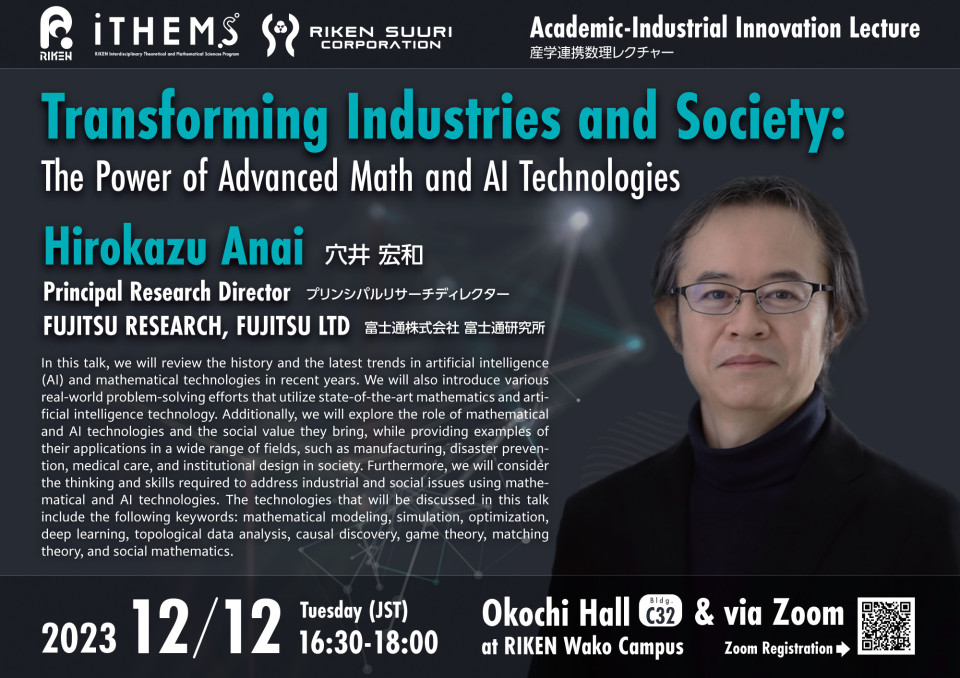Volume 275
Back to Newsletter List
Seminar Report
DMWG Seminar by Wen Yin on September 25, 2023
2023-10-31
However, we have to treat the production of DM carefully before giving up the possibility that DM of m~O(1)eV. Let us consider the production of scalar DM from decays of heavier fermion which was in the thermal equilibrium of the Universe and light compared to the background temperature. The evolution of the number density of the DM particle is obtained by solving the Boltzmann equation. Due to the bosonic nature of this DM, the number density at some specific momentum enhances significantly, showing an exponentially fast increase. This enhanced production stops when the inverse reaction of the DM production takes over. As a result, we have a DM distribution function that is significantly different from those predicted for thermally-produced ones. Note that the momentum of the produced DM is relatively low, in that sense, it can be said as "cold" DM while its mass is in the "hot" DM range.
Such a scenario can be realized in the context of particle physics. Model parameters are restricted by requiring to satisfy the relic abundance and the enhanced production to happen. We will see the signatures in the current Universe by observing at the infrared range searching for the signature of photon lines corresponding to the DM mass, which is a distinctive one!
Reported by Nagisa Hiroshima
Thermal production eV dark matter with bose-enhancement
September 25 (Mon) 15:00 - 16:30, 2023
Seminar Report
DMWG Seminar by Simon Thor on October 24, 2023
2023-10-31
The Standard Model of particle physics nicely describes our worlds, while we are not satisfied with this theory as there are phenomena we cannot explain exist. Dark matter (DM) is a famous example. The construction of the Standard Model is achieved by tremendous discoveries at collider experiments. It is a natural prediction that the extension of the Standard Model will be achieved with further discoveries at collider experiments. Hoping for such a scenario, several future collider experiments, such as the international linear collider (ILC), are now being planned.
ILC is good at probing new physics scenarios which is related to the Higgs sector of the Standard Model. The dark neutrino model is one example that contains new dark sector particles. If the mass of the dark neutrino falls between that of the weak bosons and the Higgs, the prediction can be relatively clear: characterization of the signal can be done with three parameters in the model.
Still, there are difficulties to overcome. As is usual the case, we have to find signals from data with significant background events. For example, one first makes preselection, then performs the rectangular cut (a kind of optimization), and finally tests the significance of the signal. By introducing machine learning techniques to several analysis parts the sensitivity to the model can be increased.
Test using simulation data for ILC experiments at the center-of-mass energy 250GeV, it is shown that the constraints on the dark neutrino model can be improved by one- or two orders of magnitude. Further improvement can be achieved by introducing new ideas for the analysis, which will be investigated. By increasing the number of channels to be analyzed, the mass range of the dark neutrino to be probed can also be widened.
A lot of physics has already been done with colliders, and further more is to be with new colliders and new techniques. We are boosting now!
Reported by Nagisa Hiroshima
Searching for dark neutrinos through exotic Higgs decays at the ILC
October 24 (Tue) 16:30 - 17:30, 2023
Upcoming Events
Seminar
iTHEMS Theoretical Physics Seminar
Compact Star Solutions Beyond General Relativity
November 7 (Tue) 13:30 - 15:00, 2023
Kota Numajiri (Ph.D. Student, Graduate School of Science, Nagoya University)
The neutron star solutions have been gathering attention. Their high compactness enables us to observationally access the information about extreme regimes of hadron physics. On the other hand, their strong gravity features bring up another possibility, gravity beyond general relativity (GR).
Although GR has been a great success until now, the present scenario for our universe still has several problems, such as dark sectors and the quantum description of gravity. To tackle these problems, the modified gravity theories have been discussed for decades. Their modifications are expected to become noticeable in strong gravity regimes like compact stars.
In this talk, I will discuss the configuration of the compact star solution under the F(R) gravity, one of the most popular and simplest modifications of GR. The background hydrostatic solutions are calculated with some F(R) models, which show non-trivial influences from the additional scalar DOF in this theory. The tidal deformation phenomenon is also considered to focus on another observable, tidal deformability. I will comment on how to utilize obtained observables to determine the gravity theory and the unknown equation of state simultaneously.
Venue: Seminar Room #359, 3F Main Research Building, RIKEN / via Zoom
Event Official Language: English
Seminar
iTHEMS Biology Seminar
Patterns of fern community assembly throughout the American continent: Do the mechanisms of species diversification also vary with latitude?
November 7 (Tue) 16:00 - 17:00, 2023
José Said Gutiérrez-Ortega (Special Postdoctoral Researcher, RIKEN Interdisciplinary Theoretical and Mathematical Sciences Program (iTHEMS))
The global latitudinal gradient of biodiversity, a pattern suggesting that the low-latitude (tropical) areas have more species than the high-latitude (temperate) areas, represents the most conspicuous pattern of correlation between the environmental/geographic variation and biodiversity distribution. Yet, the relative roles of all ecological, geographic, and historical variables that can explain the gradient are unclear. Specifically, it is because we do not have a clear link between latitude and the underlying mechanisms that originate and extinct species throughout the gradient. In other words, we lack a connection between the “macroevolutionary patterns" and “microevolutionary processes”. I am researching the community assembly of ferns from the American continent, as it seems to be a group that can give some answers to what causes the latitudinal gradient of biodiversity and how the gradient is related to the processes of speciation and extinction. Regarding the community assembly, as expected, I found that the fern community clearly follows the latitudinal gradient: the number of species and localities colonized by ferns decrease with latitude. Also, this pattern is associated to a strong phylogenetic structure: the community at each latitudinal area is dependent of the previously colonizing genera (in other words, genera tend to diversify within specific latitudinal spans; most of them are restricted to the tropics). These results suggest that the fern community from the American continent follows the latitudinal gradient, and that it is a good representer of this pattern. Then, using linear regressions, I tested some classical hypotheses that have been proposed to explain the latitudinal gradient (e.g., that tropical environments, being more thermodynamically active, promote higher speciation rates). However, my results so far, suggest that none of the previously proposed hypotheses give a satisfactory explanation: there is no a single factor that can link the gradient with the processes of speciation or extinction. Rather, my data suggest that to promote speciation, the relative roles of environmental differentiation, geographic isolation, niche divergence, and time since divergence between sister species pairs vary with latitude. For example, to become new species, species near the equator did not need much geographic isolation or niche divergence from their sister counterparts (i.e., near the equator, species pairs tend to be more sympatric and present higher niche overlap). I hope my talk can stimulate some discussion about how to approach and treat the data that I have compiled, and that we can create opportunities for further collaboration.
Venue: via Zoom
Event Official Language: English
Seminar
Math-Phys Seminar
Vortex Reconnection in Classical and Quantum Fluids
November 10 (Fri) 15:00 - 16:30, 2023
Yoshifumi Kimura (Professor, Graduate School of Mathematics, Nagoya University)
As a fundamental process in turbulence, vortex reconnection has been studied widely not only in classical fluids but also in quantum fluids. For the latter, the first real observation of vortex reconnection was rather recent, and since then active analyses have been continued. On the other hand, vortex reconnection in the former has a long history, and it is now studied intensively as a candidate for a solution to the problem of the regularity/Singularity of the Navier-Stokes equations, which is one of the seven millennium prize problems of the Clay Mathematical Institute.
In this talk, after introducing the problem, we will present some results of analysis and simulations of the dynamical system which has been proposed to describe a vortex reconnection of two vortex rings located symmetrically on two tilted planes [1], [2], [3]. Then it will be shown that this dynamical system can be written in noncanonical Hamiltonian form with Hamiltonian, H, and a Casimir invariant, C in the limit of zero viscosity [4].
References
- H.K. Moffatt and Y. Kimura, Towards a finite-time singularity of the Navier-Stokes equations. Part 1. Derivation and analysis of dynamical system, J. Fluid Mech. 861, 930 (2019), doi: 10.1017/jfm.2018.882
- H.K. Moffatt and Y. Kimura, Towards a finite-time singularity of the Navier-Stokes equations. Part 2. Vortex reconnection and singularity evasion, J. Fluid Mech. 870, R1 (2019), doi: 10.1017/jfm.2019.263
- H.K. Moffatt and Y. Kimura, Towards a finite-time singularity of the Navier-Stokes equations. Part 3. Vortex reconnection and singularity evasion, J. Fluid Mech. 967, R1 (2023), doi: 10.1017/jfm.2023.472
- P.J. Morrison and Y. Kimura, A Hamiltonian Description of Finite-Time Singularity in Euler’s Fluid Equation, Phys. Lett. A 484, 129078 (2023), doi: 10.1016/j.physleta.2023.129078
Venue: Seminar Room #359, 3F Main Research Building, RIKEN / via Zoom
Event Official Language: English
Workshop
iTHEMS Graph-theory workshop: from basics to applications
November 13 (Mon) - 14 (Tue) 2023
Momoko Hayamizu (Assistant Professor, Faculty of Science and Engineering, School of Fundamental Science and Engineering, Waseda University / PRESTO Researcher, Japan Science and Technology Agency (JST))
Seiya Negami (Professor Emeritus, Yokohama National University)
Takashi Okada (Program-Specific Associate Professor, Institute for Life And Medical Sciences, Kyoto University)
Tasuku Soma (Associate Professor, Department of Statistical Inference and Mathematics, The Institute of Statistical Mathematics / Associate Professor, Statistical Science Program, The Graduate University for Advanced Studies (SOKENDAI))
Shun'ichi Azuma (Professor, Garduate School of Informatics, Kyoto University)
We will hold a two-day workshop on graph theory, which covers a variety of topics including basic concepts and theorems in graph-theory; graph-embedding; phylogenetic tree construction; chemical reaction networks; and cactus network theory.
The details are found in the website linked below.
Venue: #435-437, Main Research Building, RIKEN Wako Campus
Event Official Language: English
Conference
Co-hosted by iTHEMS
MCME SYMPOSIUM 2023
November 15 (Wed) - 16 (Thu) 2023
Kyosuke Adachi (Research Scientist, RIKEN Interdisciplinary Theoretical and Mathematical Sciences Program (iTHEMS))
Hiroshi Kokubu (Executive Vice-President, Kyoto University)
Masaru Hongo (Assistant Professor, Department of Physics, Faculty of Science, Niigata University)
"MCME SYMPOSIUM 2023" will be held at the Musashino Center of Mathematical Engineering (MCME), Musashino University. This symposium is free of charge and open to everyone.
Colleagues of iTHEMS will also be speaking. Below is an excerpt from the program.
Wednesday, November 15, 11:20 - 12:30 Kyosuke Adachi
Wednesday, November 15, 16:20 - 17:30 Hiroshi Kokubu
Thursday, November 16, 10:00 - 11:10 Masaru Hongo
Registration is open until November 14. Please register from the related links below.
Organized by Musashino Center of Mathematical Engineering (MCME), Musashino University
Co-organized by RIKEN Interdisciplinary Theoretical and Mathematical Sciences Program (iTHEMS)
Venue: Hybrid Format (Room 301, Building 5, Ariake Campus, Musashino University and Zoom)
Seminar
iTHEMS Math Seminar
Geometry of special nilpotent orbits
November 15 (Wed) 14:00 - 15:30, 2023
Baohua Fu (Professor, Academy of Mathematics and Systems Science, Chinese Academy of Sciences, China)
Special nilpotent orbits play a key role in representation theory, but their geometry is little understood. I'll first report a joint work with Yongbin Ruan and Yaoxiong Wen proposing a mirror symmetry conjecture for special nilpotent orbits and then a joint work with Daniel Juteau, Paul Levy and Eric Sommers on the proof of sliced version of Lusztig's conjecture on special pieces.
Venue: via Zoom
Event Official Language: English
Workshop
6th QGG Intensive Lectures: Introduction to thermalization in isolated quantum systems
November 20 (Mon) - 21 (Tue) 2023
Ryusuke Hamazaki (RIKEN Hakubi Team Leader, Nonequilibrium Quantum Statistical Mechanics RIKEN Hakubi Research Team, RIKEN Cluster for Pioneering Research (CPR))
This is the sixth event by the Quantum Gravity Gatherings (QGG) Study Group at RIKEN iTHEMS. For this event we have invited Professor Ryusuke Hamazaki from RIKEN, to deliver pedagogical lectures on the thermalization in isolated quantum systems. This topic describes how a non-equilibrium quantum state relaxes to thermal equilibrium through a unitary time evolution. This theme has applications not only in statistical physics but also in many areas of physics. In particular, in the context of quantum gravity, understanding thermalization via a unitary time evolution is anticipated to be a key to resolving the information loss problem of black holes. In addition, the notion of typicality and thermalization is important in the AdS/CFT correspondence to understand black hole physics. We expect this event to provide insights to researchers in related fields. Ryusuke Hamazaki is a leading expert in this subject. It is our enormous pleasure to have the opportunity to learn from him the idea of thermalization and its applications related to realistic systems.
This intensive lecture series is designed to be an interactive event. The intensive talk will be given in a face-to-face blackboard style (in English, no online streaming) to encourage informal and lively Q&A discussions. The program will also include short talk sessions, where participants can present a 5-minute talk on a topic of their choice, which could be about their own research, reviews of specific works, or future study interests.
Venue: #435-437, Main Research Building, RIKEN Wako Campus
Event Official Language: English
Colloquium
iTHEMS Colloquium
Bridging physics and society: A case study of collective memory dynamics by socio-econophysics approach
November 20 (Mon) 15:00 - 16:30, 2023
Yukie Sano (Associate Professor, Institute of Systems and Information Engineering, University of Tsukuba)
The movements of individuals with free will are unpredictable, complex, and, needless to say, fundamentally distinct from the movements of matter. Furthermore, studying society, which forms collectives while engaging in intricate individual interactions, using mathematical models seems incredibly daunting. However, when analyzing empirical data, relatively simple mathematics often emerge in the distribution and dynamics of society at the level of collective behavior. Additionally, such mathematics often share commonalities with physical phenomena. With this background, research is progressing by applying ideas from physics to social-economic phenomena, a field known as socio-econophysics. In this presentation, I will introduce a mathematical model that addresses the decay of collective memory using access logs on the web as an example of research in socio-econophysics.
Venue: Okochi Hall, 1F Laser Science Laboratory, RIKEN / via Zoom
Event Official Language: English
Seminar
ABBL-iTHEMS Joint Astro Seminar
Early Formation of Dark Matter Halos
November 24 (Fri) 14:00 - 15:15, 2023
Derek Beattie Inman (Research Scientist, RIKEN Interdisciplinary Theoretical and Mathematical Sciences Program (iTHEMS))
Cosmological observations have led to an extremely precise understanding of the large-scale structure of the Universe. A common assumption is to extrapolate large-scale properties to smaller scales; however, whether this is correct or not is unknown and many well-motivated early Universe scenarios predict substantially different structure formation histories. In this seminar I will discuss two scenarios where nonlinear structures form much earlier than is typically assumed. In the first case, the initial fluctuations are enhanced on small scales leading to either primordial black holes clusters or WIMP minihalos right after matter-radiation equality. In the second, I will show that an additional attractive dark force leads to structure formation even in the radiation dominated Universe. I will furthermore discuss possible observations of such early structure formation including changes to the cosmic microwave background, dark matter annihilation, and when the first galaxies form.
Venue: Seminar Room #359, 3F Main Research Building, RIKEN / via Zoom
Event Official Language: English
Seminar
iTHEMS Seminar
Cosection localization via shifted symplectic geometry
December 6 (Wed) 10:00 - 11:30, 2023
Young-Hoon Kiem (Professor, School of Mathematics, Korea Institute for Advanced Study (KIAS), Republic of Korea)
Modern enumerative invariants are defined as integrals of cohomology classes against virtual fundamental classes constructed by Li-Tian and Behrend-Fantechi. When the obstruction sheaf admits a cosection, the virtual fundamental class is localized to the zero locus of the cosection. When the cosection is furthermore enhanced to a (-1)-shifted closed 1-form, the zero locus admits a (-2)-shifted symplectic structure and thus we have another virtual fundamental class by the Oh-Thomas construction. An obvious question is whether these two virtual fundamental classes coincide or not. In this talk, we will see that (-1)-shifted closed 1-forms arise naturally as an analogue of the Lagrange multiplier method. Furthermore, a proof of the equality of the two virtual fundamental classes and its applications will be discussed. Based on a joint work with Hyeonjun Park.
Venue: Seminar Room #359, 3F Main Research Building, RIKEN
Event Official Language: English
Seminar
ABBL-iTHEMS Joint Astro Seminar
Exploring material strengths of dust aggregates in planet formation by numerical simulations
December 8 (Fri) 14:00 - 15:15, 2023
Misako Tatsuuma (Research Scientist, RIKEN Interdisciplinary Theoretical and Mathematical Sciences Program (iTHEMS))
The planet formation process is the growth from sub-micrometer-sized cosmic dust grains to thousand-kilometer-sized planets. This growth process has broadly two phases: the growth from dust grains to kilometer-sized planetesimals, mainly driven by intermolecular forces like van der Waals forces and hydrogen bonds, and the subsequent growth from planetesimals to planets, governed by gravitational forces. However, the planetesimal formation process encounters various challenges, including fragmentation and bouncing resulting from collisions among dust aggregates. To gain insights into the planetesimal formation process and how to avoid these obstacles, I have been focused on measuring and formulating the material strengths of dust aggregates using grain simulations. In this talk, I will introduce my works on the material strengths of dust aggregates and their applications to kilometer-sized bodies in the solar system, such as comets and asteroids.
Venue: Seminar Room #359, 3F Main Research Building, RIKEN / via Zoom
Event Official Language: English
Lecture
Academic-Industrial Innovation LectureCo-hosted by RIKEN SUURI CORPORATION
Transforming Industries and Society: The Power of Advanced Math and AI Technologies
December 12 (Tue) 16:30 - 18:00, 2023
Hirokazu Anai (Principal Research Director, FUJITSU RESEARCH, FUJITSU Ltd.)
In this talk, we will review the history and the latest trends in artificial intelligence (AI) and mathematical technologies in recent years. We will also introduce various real-world problem-solving efforts that utilize state-of-the-art mathematics and artificial intelligence technology. Additionally, we will explore the role of mathematical and AI technologies and the social value they bring, while providing examples of their applications in a wide range of fields, such as manufacturing, disaster prevention, medical care, and institutional design in society. Furthermore, we will consider the thinking and skills required to address industrial and social issues using mathematical and AI technologies. The technologies that will be discussed in this talk include the following keywords: mathematical modeling, simulation, optimization, deep learning, topological data analysis, causal discovery, game theory, matching theory, and social mathematics.
Venue: Okochi Hall, 1F Laser Science Laboratory, RIKEN / via Zoom
Event Official Language: English
Workshop
Second Workshop on Fundamentals in Density Functional Theory (DFT2024)
February 20 (Tue) - 22 (Thu) 2024
The density functional theory (DFT) is one of the powerful methods to solve quantum many-body problems, which, in principle, gives the exact energy and density of the ground state. The accuracy of DFT is, in practice, determined by the accuracy of an energy density functional (EDF) since the exact EDF is still unknown. Currently, DFT has been used in many communities, including nuclear physics, quantum chemistry, and condensed matter physics, while the fundamental study of DFT, such as the first principle derivations of an accurate EDF and methods to calculate many observables from obtained densities and excited states. However, there has been little opportunity to have interdisciplinary communication.
On December 2022, we had the first workshop on this series (DFT2022) at Yukawa Institute for Theoretical Physics, Kyoto University, and several interdisiplinary discussions and collaborationd were started. To share such progresses and extend collaborations, we organize the second workshop. In this workshop, the current status and issues of each discipline will be shared towards solving these problems by meeting together among researchers in mathematics, nuclear physics, quantum chemistry, and condensed matter physics.
This workshop mainly comprises lectures/seminars on cutting-edge topics and discussion, while a half-day session composed of contributed talks is also planned.
This workshop is partially supported by iTHEMS-phys Study Group. This workshop is a part of the RIKEN Symposium Series.
The detailed information can be found in the workshop website.
Venue: 8F, Integrated Innovation Building (IIB), Kobe Campus, RIKEN / via Zoom
Event Official Language: English
Paper of the Week
Week 1, November 2023
2023-11-02
Title: Exploring Neutrino Mass Orderings through Supernova Neutrino Detection
Author: Maria Manuela Saez
Journal Reference: Universe 2023, 9, 464
doi: https://doi.org/10.3390/universe9110464
arXiv: http://arxiv.org/abs/2310.19939v1
Title: Inhomogeneous quenches as state preparation in two-dimensional conformal field theories
Author: Masahiro Nozaki, Kotaro Tamaoka, Mao Tian Tan
arXiv: http://arxiv.org/abs/2310.19376v1
Title: The homology of moduli spaces of 4-manifolds may be infinitely generated
Author: Hokuto Konno
arXiv: http://arxiv.org/abs/2310.18695v1
If you would like to cancel your subscription or change your email address,
please let us know via our contact form.
Copyright © iTHEMS, RIKEN. All rights reserved.



